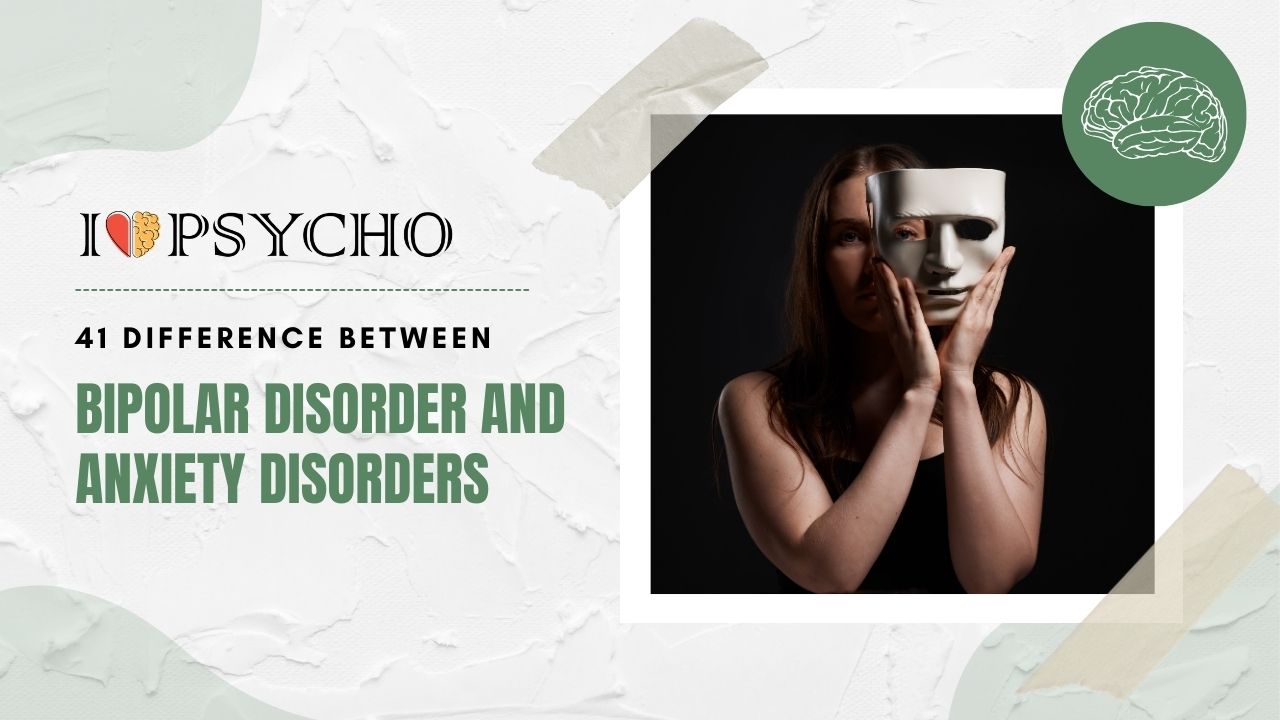Bipolar disorder and anxiety disorders have similar symptoms but different origins, symptoms, and treatments. Extreme mood swings between mania (elevated mood, vitality, impulsivity) and depression (low mood, tiredness, hopelessness) characterize bipolar disorder. These mood swings are stronger than usual. Instead, anxiety disorders such as generalized anxiety disorder, panic disorder, and social anxiety disorder cause excessive concern, fear, and apprehension. Bipolar disorder and anxiety disorders both have anxiety symptoms, however, the types differ.
An important difference between conditions is their primary emotions. Bipolar disorder involves manic or hypomanic phases (high energy and euphoria) followed by depressed spells. These events may cause anxiety, but mood changes are more important. However, anxiety disorders are characterized by excessive worry and terror. Anxiety disorders cause continual concern, panic attacks, and extreme social anxiety, but they do not cause manic highs and depressed lows like bipolar illness.
Treatment method is another key distinction. Lithium or antipsychotics are used to treat manic and depressed episodes in bipolar disorder, coupled with treatment for emotional and cognitive issues. In contrast, anxiety disorders are treated with CBT, medication (such as selective serotonin reuptake inhibitors), or both to reduce symptoms and manage triggers.
The development and progression of various disorders vary. Recurrent mood episodes characterize bipolar disorder, which generally develops in late adolescence or early adulthood. However, anxiety disorders can emerge at any age and may start gradually, frequently due to life events or pressures.
While bipolar illness and anxiety disorders have some same symptoms, they are separate mental health problems with different affective states, treatment methods, and trajectories. Since various illnesses have different management tactics, a skilled mental health practitioner must diagnose the issue accurately to give appropriate therapy and support.
|
S.No. |
Aspect |
Bipolar Disorder |
Anxiety Disorders |
|
1 |
Type of Disorder |
Mood Disorder |
Anxiety Disorder |
|
2 |
Primary Symptoms |
Mood swings (mania and depression) |
Excessive anxiety or fear |
|
3 |
Mood Episodes |
Manic, depressive, hypomanic |
N/A (no distinct mood episodes) |
|
4 |
Duration of Symptoms |
Weeks to months in mood episodes |
Chronic, often for six months or more |
|
5 |
Mood Stability |
Fluctuates between extremes |
Generally stable mood |
|
6 |
Key Feature |
Shifts in mood and energy levels |
Excessive worry or fear |
|
7 |
Cognitive Patterns |
Impaired judgment during mania |
Excessive rumination and anxious thoughts |
|
8 |
Physical Symptoms |
Increased energy (mania), fatigue (depression) |
Physical symptoms (e.g., palpitations) |
|
9 |
Emotional Symptoms |
Elation or irritability (mania), sadness (depression) |
Worry, fear, restlessness |
|
10 |
Social Impact |
May strain relationships |
May impact social interactions |
|
11 |
Specific Fears |
Fears not a primary feature |
Specific phobias, panic attacks |
|
12 |
Comorbidity |
Commonly co-occurs with anxiety disorders |
Commonly co-occurs with mood disorders |
|
13 |
Treatment Approach |
Mood stabilizers, psychotherapy |
Antidepressants, therapy |
|
14 |
Medication Types |
Mood stabilizers, antipsychotics |
Antidepressants, benzodiazepines |
|
15 |
Goal of Treatment |
Stabilize mood and prevent relapse |
Reduce anxiety and improve coping |
|
16 |
Prognosis |
Generally manageable with treatment |
Often manageable with treatment |
|
17 |
Safety Behaviors |
May engage in risky behaviors during manic episodes |
May avoid anxiety triggers or situations |
|
18 |
Intrusiveness of Thoughts |
Thoughts influenced by mood state |
Intrusive, anxiety-related thoughts |
|
19 |
Ritualistic Behavior |
Not a characteristic feature |
Not a characteristic feature |
|
20 |
Fear of Consequences |
May not consider consequences during mania |
Fear of specific consequences (e.g., panic) |
|
21 |
Insight |
Variable, often impaired during mania |
Generally maintains insight |
|
22 |
Perfectionism |
May exhibit impulsivity during mania |
Perfectionism not a primary feature |
|
23 |
Recurrence |
Often episodic with mood episodes |
Chronic, often with remissions |
|
24 |
Awareness of Symptoms |
Aware of mood shifts |
Aware of excessive anxiety or fear |
|
25 |
Control over Symptoms |
Limited control during mood episodes |
Limited control over anxiety symptoms |
|
26 |
Thought Content |
May have grandiose or racing thoughts during mania |
Obsessive or irrational thoughts |
|
27 |
Response to Triggers |
Mood episodes triggered by stressors |
Anxiety triggered by specific situations |
|
28 |
Avoidance Behaviors |
May engage in risk-taking behaviors |
May avoid anxiety-provoking situations |
|
29 |
Relationship Impact |
May strain relationships |
May strain relationships |
|
30 |
Impact on Daily Functioning |
Can significantly disrupt daily life |
Can disrupt daily life, but to a lesser extent |
|
31 |
Need for Reassurance |
May seek reassurance during mood episodes |
Commonly seeks reassurance |
|
32 |
Specific Diagnostic Criteria |
Follows criteria specific to Bipolar Disorder |
Follows criteria specific to Anxiety Disorders |
|
33 |
CBT Techniques |
Not a primary treatment approach |
Cognitive Behavioral Therapy (CBT) |
|
34 |
Diagnostic Tool |
Diagnosed using DSM-5 criteria |
Diagnosed using DSM-5 criteria |
|
35 |
Preoccupation with Thoughts |
Preoccupied with mood-related thoughts |
Preoccupied with anxiety-related thoughts |
|
36 |
Coping Mechanisms |
May use risky behaviors as coping |
May use avoidance or reassurance as coping |
|
37 |
Impact on Sleep |
Sleep patterns affected during mood episodes |
Sleep patterns affected by anxiety |
|
38 |
Secondary Anxiety Symptoms |
Anxiety may co-occur during depressive episodes |
N/A (anxiety is primary symptom) |
|
39 |
Family History |
Family history of mood disorders |
Family history of anxiety disorders |
|
40 |
Risk of Depression |
At risk during depressive episodes |
At risk of comorbid depression |
|
41 |
Awareness of Irrationality |
Variable; may lack insight during manic episodes |
Generally maintains insight |
Frequently Asked Questions (FAQs)
Q1: What distinguishes bipolar illness from anxiety disorders?
Bipolar disorder entails significant mood swings between manic and depressed periods, whereas anxiety disorders involve excessive worry and dread. Bipolar disorder comprises mood-related symptoms, while anxiety disorders cause worry and fear.
Q2: Do bipolar illness symptoms include anxiety?
Bipolar illness can cause anxiety, especially during depressed periods or mood swings. However, bipolar disorder anxiety differs from main anxiety illnesses. Anxiety is the main symptom of anxiety disorders, although typically subsequent to mood abnormalities in bipolar illness.
Q3: How are these illnesses diagnosed, and why is accuracy crucial?
A trained mental health professional must diagnose accurately. Diagnostics usually entail a thorough review of symptoms, history, and clinical presentation. Treatment methods vary, thus accurate diagnosis is crucial. Misdiagnosis might exacerbate the illness and cause incorrect therapy.
Q4: What are the treatment options for bipolar disorder and anxiety disorders?
Bipolar disorder treatment frequently includes counseling and mood-stabilizing drugs like lithium and antipsychotics to control manic and depressed episodes. CBT, medication, or both are used to treat anxiety disorders. Treatment seeks to reduce anxiety, control stressors, and enhance quality of life.
Q5: Have these disorders distinct onsets and courses?
Yes, they do Recurrent mood episodes characterize bipolar disorder, which generally develops in late adolescence or early adulthood. Anxiety problems can start at any age and can progress slowly. They are generally caused by life events or pressures and can become chronic if ignored.









